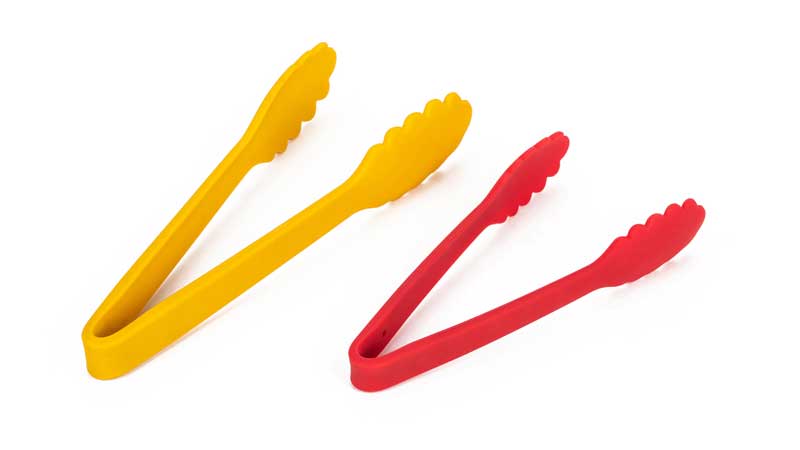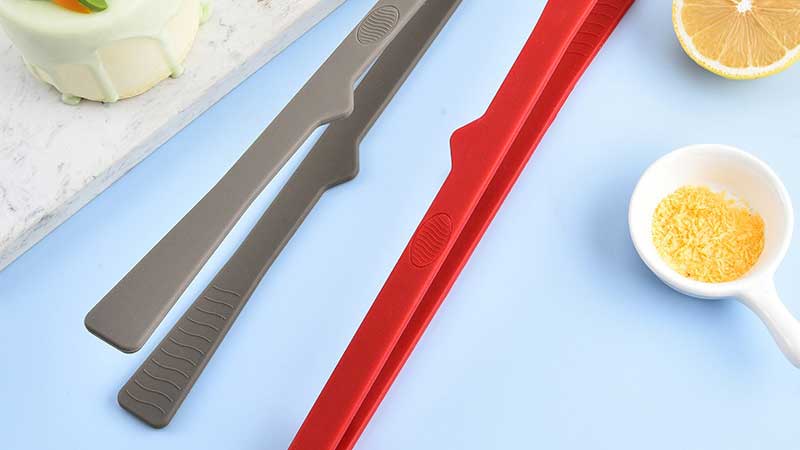In every kitchen, tongs are among the most frequently used tools. The most common types are made from metal, plastic, or silicone. As food safety awareness grows, more households and restaurants are switching to silicone tongs. But what makes them better than metal or plastic ones? Let’s take a closer look.

What Are the Differences Between Silicone, Metal, and Plastic Tongs?
The table below compares their main performance aspects:
| Feature | Silicone Tongs | Metal Tongs | Plastic Tongs |
| Heat Resistance | 200–300°C, no deformation | High heat tolerance but conducts heat quickly, can burn hands | Over 120°C may deform or melt |
| Flexibility | Soft and elastic, not easy to break | Rigid, may scratch cookware | Brittle, prone to breaking |
| Food Safety | Food-grade silicone, chemically stable | May react with acidic or alkaline foods | May release BPA or other chemicals |
| Hygiene | Smooth, non-porous, easy to clean | Can rust, needs drying | Can scratch easily, harbors bacteria |
| Comfort | Non-slip, heat-insulated, comfortable to use | Conducts heat, may feel hot | Lightweight but slippery |
| Durability | Long lifespan, no aging or deformation | May rust or discolor | Short lifespan |
| Eco-friendliness | Reusable and recyclable | Recyclable but energy-intensive to make | Not eco-friendly, hard to recycle |
| Cost-effectiveness | Slightly higher cost but long-lasting | Moderate price | Cheap but easily damaged |
From the comparison, silicone tongs clearly outperform the others in heat resistance, safety, flexibility, and hygiene. Let’s explore these advantages in detail.
What Are the Key Advantages of Silicone Tongs?
Excellent Heat Resistance
Silicone can handle high temperatures up to 300°C without deforming or producing odor. This makes it ideal for cooking, baking, or grilling. Plastic tongs soften or melt above 120°C, posing safety risks. Metal tongs tolerate heat but conduct it quickly, often burning hands without insulation. Silicone tongs combine a metal core for strength with a silicone coating for heat protection, giving both stability and comfort.
Safe and Non-toxic
Food-grade silicone is chemically inert. It doesn’t react with food or release harmful substances like BPA or phthalates. Metal tongs can react with acidic foods, affecting taste and safety. Silicone tongs stay neutral, handle hot oils and foods safely, and meet modern kitchen hygiene standards.

Gentle on Cookware
Non-stick and ceramic pans can be easily scratched by metal tongs. Silicone tongs, with their soft and smooth tips, protect cookware while firmly gripping slippery foods like shrimp, steak, or vegetables. They combine flexibility with stability, something metal and plastic cannot achieve.
Easy to Clean
Silicone is non-porous, so it doesn’t absorb water, oil, or odors. You can rinse it with warm water or place it in a dishwasher for effortless cleaning. Plastic tongs often leave oil stains and scratches that trap bacteria. Metal tongs can rust if not dried properly. Silicone tongs are dishwasher-safe and can even be sterilized, ensuring hygiene in both home and commercial kitchens.
Long-lasting Durability
Silicone is highly resistant to aging. It does not crack, deform, or lose elasticity over time, even when exposed to heat, moisture, or oil. Plastic tongs often become sticky or break, while metal ones discolor or corrode. Silicone tongs remain flexible and reliable for years with minimal maintenance.
Environmentally Friendly
Silicone is durable, reusable, and recyclable. It reduces waste by lasting longer and needing fewer replacements. It also produces no harmful byproducts during manufacturing or use. For eco-conscious consumers, silicone tongs represent a smart and sustainable choice.
Great Value for Money
Although silicone tongs cost slightly more upfront, they last longer, require less care, and protect your cookware. They also prevent burns and food waste caused by slipping. In the long run, silicone tongs offer the best overall value for both home cooks and professionals.

Conclusion
Overall, silicone tongs outperform metal and plastic ones in heat resistance, safety, flexibility, hygiene, durability, eco-friendliness, and value. They make cooking safer, easier, and more enjoyable while supporting a healthier and more sustainable lifestyle.
If you’re looking to customize high-quality silicone products, contact us. With over ten years of experience in silicone manufacturing and advanced production technology, we can provide complete customization solutions from design to finished product.